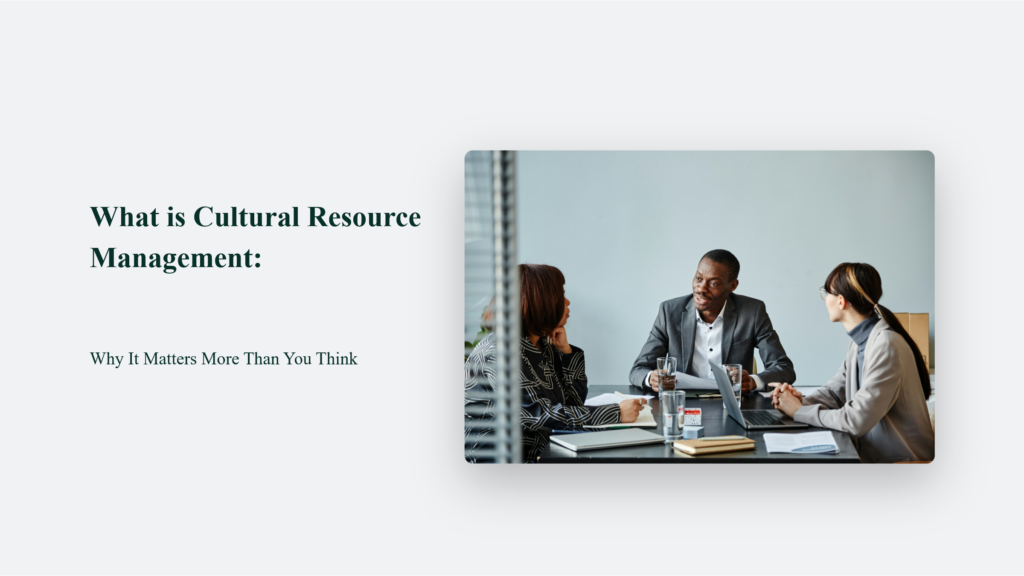Let’s face it: when you hear “cultural resource management,” your eyes probably glaze over faster than a tourist at their fifth museum of the day. But here’s the kicker: this seemingly dry topic is the backbone of preserving our identity, shaping our future, and even making a buck or two. So buckle up because we’re about to dive into what is cultural resource management (CRM) and why it’s more fascinating – and vital – than you ever imagined.

What is Cultural Resource Management, Anyway?
Before we go any further, let’s get one thing straight: cultural resource management isn’t just about dusting off old relics or roping off ancient ruins. It’s a comprehensive approach to identifying, evaluating, and protecting our cultural heritage through practices, laws, and frameworks governing cultural resource conservation and management. It includes everything from archaeological sites and historic buildings to cultural landscapes and ethnographic resources. In essence, it’s about preserving the physical evidence of past human activities and the knowledge embedded in our cultural objects.
Authoritative sources like the National Park Service and the American Cultural Resources Association define and utilise cultural resources in CRM. These resources encompass archaeological, historical, and tangible and intangible assets, all managed within specific legal frameworks and practices.
The concept of CRM, as we know it today, emerged in the 1960s and 1970s, largely in response to the destruction of historic sites and archaeological resources due to rapid development. In Australia, the Aboriginal and Torres Strait Islander Heritage Protection Act 1984 was a historic moment, recognising the importance of preserving Indigenous Cultural Heritage.
Today, CRM involves a wide range of activities, including:
- Archaeological excavations and surveys
- Architectural history studies
- Ethnographic research
- Conservation of historical objects and sites
- Development of management plans for cultural landscapes
- Public education and outreach programs
Applying specific principles collectively in all cultural resource management activities is crucial.
The Uncomfortable Truth About Our Cultural Heritage Management
Now, brace yourself because this is where things get a bit grim. Our cultural heritage is disappearing at an alarming rate. According to UNESCO, armed conflicts have damaged or destroyed hundreds of heritage sites in recent years. But it’s not just war that’s the problem. Development, natural disasters, and plain old neglect are all taking their toll.
In Australia, we’re not immune to this trend. A 2020 study found that over 7,000 indigenous heritage sites have been destroyed or damaged in the past decade alone. Preserving cultural resources through qualified archaeologists who meet professional standards is essential to mitigate these losses. That’s not just a loss of pretty artefacts – it’s a loss of knowledge, identity, and economic potential. We are responsible for preserving these resources for present and future generations.
Yes, you read that right. Economic potential. Cultural heritage isn’t just about warm fuzzy feelings; it’s big business. Globally, cultural tourism
Why You Should Give a Damn About CRM
At this point, you might be thinking, “Okay, so some old stuff gets destroyed. Why should I care?” Well, buckle up because I’m about to hit you with some truth bombs that’ll make you sit up and take notice.
First, let’s talk environment. Cultural resources often complement natural resources. For instance, many of our national parks protect both natural landscapes and cultural heritage sites. Preserving cultural landscapes
The Not-So-Obvious Challenges in CRM
Now, if cultural resource management was all sunshine and rainbows, we wouldn’t be in the mess we’re in. The truth is that CRM faces some serious challenges, and they’re not always the ones you’d expect.
First up, there’s the classic development vs. preservation showdown. It’s easy to say we should preserve everything, but the reality is more complex. Sometimes, development is necessary for community growth and economic stability. The trick is finding a balance, and that’s where things get tricky.
Then there’s the funding issue. Let’s face it: preserving history isn’t cheap. In Australia, heritage conservation often relies heavily on government funding, which can be inconsistent and inadequate. According to the National Trust, Australia invests less than 1% of its annual budget in heritage conservation. That’s a pretty paltry sum for something so important.
However, perhaps the most insidious challenge is the political and legal hurdle course that CRM often has to navigate. Laws and policies around cultural heritage can be complex and sometimes contradictory. Add in the often contentious issues of land rights and indigenous heritage, and you’ve got a recipe for some serious headaches.
How Australia is Screwing Up (And Occasionally Winning) at CRM
Alright, it’s time for some tough love. Australia, we need to talk about your cultural resource management game. It’s a bit of a mixed bag.
On the one hand, we’ve got some world-class examples of CRM. The management of the Greater Blue Mountains World Heritage Area is a standout. This massive area, covering over a million hectares, is managed to protect both its natural and cultural values, including indigenous heritage sites and historic mining areas. It’s a prime example of how natural and cultural resource management can work hand in hand.
But then we’ve got situations like the Juukan Gorge disaster we mentioned earlier, or the ongoing debates about development in areas of cultural significance, like the Western Highway project in Victoria, which threatened ancient trees sacred to indigenous people.
The truth is that Australia’s approach to CRM often falls short when it comes to indigenous heritage. Despite having some of the oldest continuing cultures in the world, our track record on protecting indigenous cultural resources is… let’s just say it leaves a lot to be desired.
However, it’s not all doom and gloom. There are signs of change. The outcry over the destruction of the Juukan Gorge has led to reviews of heritage protection laws. Innovative approaches are emerging, like using digital technologies to document and preserve cultural heritage.
For instance, the Aboriginal Areas Protection Authority in the Northern Territory uses drones and 3D mapping to document sacred sites, making it easier to protect them from accidental damage. It’s a prime example of how technology can enhance our cultural resource management practices.
The Future of Cultural Resource Management: It’s Not What You Think
Now, let’s gaze into our crystal ball and see what the future holds for CRM. Spoiler alert: it’s not just more of the same.
First up, technology is set to revolutionise how we manage cultural resources. We’re talking AI that can help identify and catalogue artefacts, virtual reality that can recreate historical sites, and blockchain technology that could revolutionise provenance tracking for cultural objects.
But it’s not just about fancy gadgets. The future of CRM is also about changing perceptions and increasing engagement. We’re shifting towards more inclusive approaches that recognise diverse cultural values and involve local communities in decision-making processes.
In Australia, there is a growing recognition of the need to integrate indigenous knowledge and practices into CRM. This could lead to more holistic approaches that reflect our diverse cultural landscape.
Another trend to watch is the increasing focus on intangible cultural heritage. Preserving physical objects is no longer enough; it’s about safeguarding traditions, skills, and knowledge. It could lead to some fascinating developments in how we approach CRM.
What You Can Do: Because You’re Not Off the Hook
Alright, so you’re convinced that cultural resource management matters. But what can you, as an average Joe or Jane, actually do about it? More than you might think, as it turns out.
First off, educate yourself. Learn about the cultural heritage in your local area. Visit museums, attend cultural events, and engage with local history. The more you know, the more you’ll care, and the more likely you are to speak up when it matters.
Secondly, get involved. Many heritage organisations rely on volunteers. Whether it’s helping out at a local museum, participating in archaeological digs, or assisting with conservation projects, there are plenty of opportunities to get your hands dirty (sometimes literally) in CRM.
Thirdly, use your voice. Support policies and politicians that prioritise cultural heritage protection. When development projects threaten cultural resources in your area, speak up. Your voice matters more than you might think.
And finally, put your money where your mouth is. Support museums and heritage sites with your patronage. Choose tourism experiences that respect and preserve cultural heritage. Every dollar you spend is a vote for what you value.
Conclusion: Why Cultural Resource Management Should Matter to Every Australian
So, there you have it. Cultural resource management: not nearly as boring as you thought, right? From preserving our past to shaping our future, from boosting our economy to strengthening our communities, CRM touches every aspect of our lives, whether we realise it or not.
Cultural resources are like the air we breathe – we often don’t notice them until they’re gone. But once they’re gone, they’re gone for good. And with them goes a piece of our identity, knowledge, and potential.
So the next time you hear about a heritage site under threat or a debate about cultural resource management, don’t just shrug and move on. Remember: this stuff matters. It matters to our economy, our environment, our communities, and our future.
Because here’s the thing: cultural resources aren’t just about the past. They’re about who we are, where we came from, and where we’re going. And that, my friends, is something worth giving a damn about.
Frequently Asked Questions:
Why is cultural resource management important for Australia?
CRM is crucial for Australia for several reasons:
– Preserving Indigenous Heritage: Australia has one of the oldest continuous cultures in the world, and CRM helps protect and respect this invaluable heritage.
– Economic Benefits: Cultural tourism is a significant contributor to Australia’s economy.
– National Identity: Cultural resources help shape and maintain Australia’s unique national identity.
– Education: These resources provide invaluable opportunities for learning about our history and culture.
– Environmental Protection: Many cultural landscapes also have significant ecological value.




